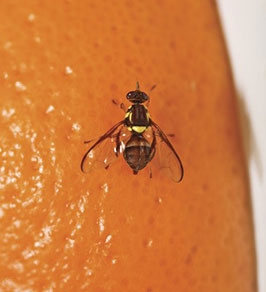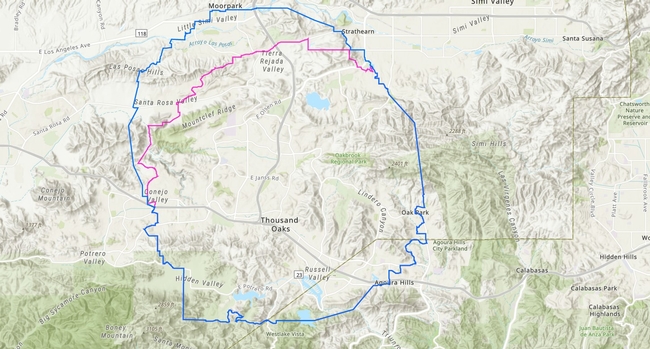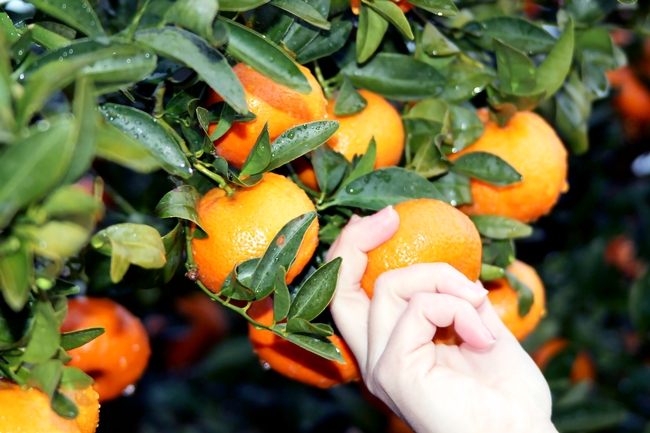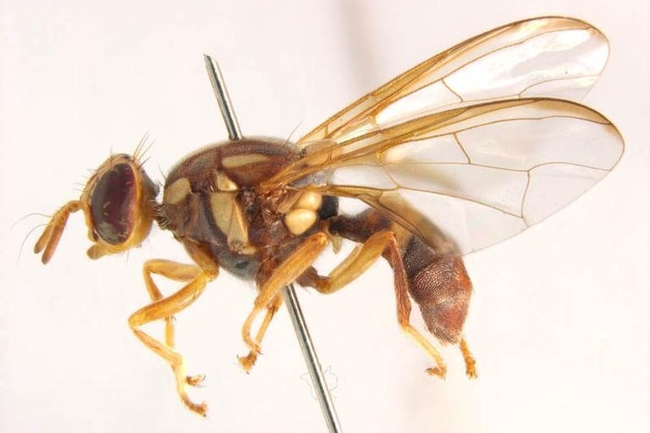Posts Tagged: QFF
Lawn-pocalypse! Surviving Drought
Ah, summer! The season of sunburns, pool parties, and… lawn droughts. If your once lush, green carpet now looks like a crunchy brown doormat, you're not alone. Let's dive into why your yard is staging a dramatic death scene and what you can do to...

Bermuda grass and weeds overtaking drought stressed turf grass.
Notes from a Neighbor - Grower
This is a recent opinion piece in the Ventura Star, Santa Paula Times and Thousand Oaks Acorn by grower Lisa Tate:
OPINION (https://www.vcstar.com/opinion/)
Letters to the editor: Be an Ag hero with fruit flies
Ventura County Star
Keep your fruit in your backyard
Re: your Oct. 27 story, “Fruit fly in T.O. prompts county's second quarantine”: (https://www.vcstar.com/story/news/2023/10/26/ventura-county-quarantine-invasive-queensland-fruit-flies-thousand-oaks-california/71176056007/)
Ventura County residents have always shown their dedication to preserving local agriculture. Today, our farmers urgently need your help.
Recently, the Queensland fruit fly was discovered in backyard fruit trees in the Thousand Oaks area. As a result, agricultural zones in T.O. and Moorpark are now under quarantine. The CDFA, USDA, and our County Agricultural Commissioner's Office are working tirelessly to shield our local farms from this destructive pest.
The repercussions of losing this battle could be catastrophic for our county and our SOAR-protected agricultural lands. Fruit fly infestations can wipe out entire crops and impede our farmers from selling their produce locally and globally — and the exorbitant costs of treating crops to prevent infestations could force some cherished family farms out of business.
What can you do to help save Ventura County agriculture? Don't move your fruit. Be an Ag hero and keep your fruit in your backyard. Prevent the spread of fruit flies and protect our local farms by not moving your backyard fruit. Dispose of excess backyard fruit by double bagging it and placing it in the trash, not the yard waste bin for composting. If you're visiting friends or family this holiday season, resist the urge to bring home backyard fruit from other areas — don't pack a pest back to Ventura.
You can be an Ag hero. Spread awareness about the risks of moving backyard fruit, and kindly refrain from sharing your bounty with friends and family this holiday season. Let's unite as a community of Ag heroes and help protect our local farms. Taking these small steps can make a significant impact and safeguard the future of our SOAR Ag lands.
Lisa Tate
Queensland Fruit Fly - Bactrocera tryoni
90 Square Miles Quarantined
An agricultural quarantine in Ventura County, due to the discovery of a potentially destructive insect pests, has been expanded. The quarantine was declared in parts of Ventura County in October following the discovery of two Queensland Fruit Flies (QFF). The flies are native to Australia.
The Ventura County quarantine is the first one ever in the United States. They are extremely destructive, laying eggs in a variety of fruits and vegetables, and destroying the produce in the process.
Because of the mild climate, Californias are able to grow and enjoy some of the best produce I the world. Actually, many countries depend on Calfirnia-grown products. Is through the surveillance and vigialance effort of the Calfornia Department of Food and AGriducltture that thise abundant food supply is protected. One fo the biggest threst to CAlfiornia agrulgulture is th exotic fruit fly. They cn enter the country by land, sea or air. These invasive pest can werak havoc on farms, orchards and backyard produce. Over 270 crops area at risk of being infected by various species of fruit flies.
The quarantine was expanded from 76 to 90 square miles after the recent discovery of a third fly. The finds have been in the Conejo Valley. The flies were found in residential trees, but there are about 3400 acres of commercial farmland in the quarantine area. A major trapping program is underway to limit the spread of the flies, with some limited pesticide spraying occurring. The adult fly is moved by humans and the wind. The larvae (the "worm" stage) is mainly moved by moving the fruit - by humans, that is.
On the map, the original limit of the quarantine was the red line, but as now been expanded to the whole blue line area.
Queensland Fruit Fly is just one of the fly quarantines in the state. There are seven currently for Oriental Fruit Fly, Mediterranean Fruit Fly and Tau Fruit Fly in Northern California, Los Angeles, Riverside and San Bernardino Counties. The state is under siege.
-
Mediterranean fruit fly: Los Angeles County, Leimert Park Area
-
Oriental fruit fly: San Bernardino and Riverside Counties, Redlands and Yucaipa Areas
-
Oriental fruit fly: Sacramento County, Rancho Cordova Area
-
Oriental fruit fly: Contra Costa County, Brentwood Area
-
Oriental fruit fly: Santa Clara County, Santa Clara Area
-
Queensland fruit fly: Ventura and Los Angeles Counties, Thousand Oaks Area
Options for Host Fruit and Vegetables-Processing
To prevent the spread of fruit flies via infested homegrown fruits and vegetables, residents and people moving through the fruit fly eradication area are urged not to move any fruits or vegetables from their property. Fruits and vegetables may be consumed or processed (i.e. juiced, frozen, cooked, or ground in the garbage disposal) at the property of origin. If they are not consumed or processed, dispose of them by double-bagging them in plastic bags and putting the bags in the garbage bin for collection.
Eradication Procedure
To eradicate exotic fruit fly infestations, CDFA uses an organically-formulated version of the pesticide called spinosad. Spinosad is used for organic crop production in California to control a variety of pests. It is mixed with a bait that is selectively attractive to fruit flies. The bait is applied as a paste that the fly eats, resulting in death. Before CDFA applies the material in the quarantine area, the homeowner will be contacted. The official registration label is available for viewing here:
https://ucanr.edu/sites/fruitandnut/files/74136.pdf
To report a suspected infestation of fruit fly larvae in homegrown produce, call the CDFA pest hotline at 1-800-491-1899. Growers with questions and concerns are urged to contact their local agricultural commissioner's office. More information about the flies and their treatment can be found at the CDFA website - www.cdfa.ca.gov/plant.
First-ever Queensland fruit fly quarantine restricts moving homegrown produce
QFF quarantine in LA, Ventura counties among seven fruit fly quarantines statewide
Residents in multiple Southern California and Northern California counties should not move homegrown fruits and vegetables from their properties to help contain several species of fruit fly that can destroy crops and impact the livelihoods of local farmers.
With sharing and gifting of food integral to the holiday season, the California Department of Food and Agriculture is reminding people to heed the seven active fruit fly quarantines aimed at controlling the Mediterranean fruit fly, Oriental fruit fly, Tau fly and Queensland fruit fly. The links below describe quarantine zone boundaries:
- Mediterranean fruit fly: Los Angeles County, Leimert Park Area
- Oriental fruit fly: San Bernardino and Riverside Counties, Redlands and Yucaipa Areas
- Oriental fruit fly: Sacramento County, Rancho Cordova Area
- Oriental fruit fly: Contra Costa County, Brentwood Area
- Oriental fruit fly: Santa Clara County, Santa Clara Area
- Tau fly: Los Angeles County – Stevenson Ranch, Valencia, Santa Clarita Areas
- Queensland fruit fly: Ventura and Los Angeles Counties, Thousand Oaks Area
People within these zones should consume or process (i.e., juice, freeze or cook) their homegrown fruits and vegetables at the place of origin and not move them off their property. Uneaten produce should be double-bagged in plastic bags and disposed of in the landfill bin – not compost or green waste.
Queensland fruit fly threatens California citrus, other crops
The Queensland fruit fly (Bactrocera tryoni) quarantine is the first of its kind in the U.S. Although QFF was first seen in California in 1985, the recent detection of two adult males triggered the unprecedented quarantine action by USDA's Animal and Plant Health Inspection Service and CDFA.
“This pest has earned a bad reputation for wreaking havoc on fruit production in Australia, where it is native,” said Hamutahl Cohen, University of California Cooperative Extension entomology advisor for Ventura County. “Adult flies lay their eggs in fruit, and the eggs hatch into larvae that then feed on the fruit, causing damage.”
And while females of other fruit fly species live for only two or three months, QFF females are unique in that they can live up to a year, according to Cohen.
“Once QFF populations take root, they're challenging to manage because females can each lay up to 100 eggs per day,” Cohen said.
In addition to being highly adaptable to a variety of environmental conditions, QFF has more than 170 host plants – including a wide range of California commodities such as citrus, grape, strawberry, fig, avocado, apricot, peach, cherry, nectarine, plum, pear, apple, tomato and sweet pepper.
The threat to citrus is especially concerning, as Southern California growers continue to grapple with the specter of spreading huanglongbing (HLB) disease, which kills citrus trees. Cohen said residents of citrus-growing regions can do their part to help their neighbors and local economy by respecting quarantine restrictions.
“Growers are already dealing with other invasive species like Asian citrus psyllid [vector of HLB pathogen], so we as homeowners need to prevent the spread of fruit flies to reduce the burden on them,” she explained.
While a spike this year in the detections of multiple fruit fly species was likely caused by a host of factors, Cohen speculates that increased post-pandemic travel is helping to move the flies. And with holiday travel in full swing, she said it's important to practice “Don't Pack a Pest” principles.
“Invasive species often hitchhike on fruits and vegetables brought into California by travelers – that's why we often first find invasive species in urban and suburban backyards, and not on farms,” Cohen said. “Travelers entering the U.S. can visit dontpackapest.com to learn about which products they can and cannot bring back with them.”
To report a suspected infestation of fruit fly larvae in homegrown produce, call the CDFA pest hotline at 1-800-491-1899. Growers with questions and concerns are urged to contact their local agricultural commissioner's office.
Climate-Change Resources
University of California UC ANR Green Blog (Climate Change and Other Topics) https://ucanr.edu/blogs/Green/index.cfm?tagname=climate%20change (full index)
Examples:
- Save Trees First: Tips to Keep Them Alive Under Drought https://ucanr.edu/b/~CdD
- Landscaping with Fire Exposure in Mind: https://ucanr.edu/b/~G4D
- Cities in California Inland Areas Must Make Street Tree Changes to adapt to Future Climate https://ucanr.edu/b/~oF7
Drought, Climate Change and California Water Management Ted Grantham, UC Cooperative Extension specialist (23 minutes) https://youtu.be/dlimj75Wn9Q
Climate Variability and Change: Trends and Impacts on CA Agriculture Tapan Pathak, UC Cooperative Extension specialist (24 minutes) https://youtu.be/bIHI0yqqQJc
California Institute for Water Resources (links to blogs, talks, podcasts, water experts, etc.) https://ciwr.ucanr.edu/California_Drought_Expertise/
UC ANR Wildfire Resources (publications, videos, etc.) https://ucanr.edu/News/For_the_media/Press_kits/Wildfire/ (main website)
-UC ANR Fire Resources and Information https://ucanr.edu/sites/fire/ (main website)
-Preparing Home Landscaping https://ucanr.edu/sites/fire/Prepare/Landscaping/
UC ANR Free Publications https://anrcatalog.ucanr.edu/ (main website)
- Benefits of Plants to Humans and Urban Ecosystems: https://anrcatalog.ucanr.edu/pdf/8726.pdf
-Keeping Plants Alive Under Drought and Water Restrictions (English version) https://anrcatalog.ucanr.edu/pdf/8553.pdf
(Spanish version) https://anrcatalog.ucanr.edu/pdf/8628.pdf
- Use of Graywater in Urban Landscapes https://anrcatalog.ucanr.edu/pdf/8536.pdf
- Sustainable Landscaping in California https://anrcatalog.ucanr.edu/pdf/8504.pdf
Other (Non-UC) Climate Change Resources
Urban Forests and Climate Change. Urban forests play an important role in climate change mitigation and adaptation. Active stewardship of a community's forestry assets can strengthen local resilience to climate change while creating more sustainable and desirable places to live. https://www.fs.usda.gov/ccrc/topics/urban-forests
Examining the Viability of Planting Trees to Mitigate Climate Change (plausible at the forest level) https://climate.nasa.gov/news/2927/examining-the-viability-of-planting-trees-to-help-mitigate-climate-change/
Reports and other information resources coordinated under the auspices of the United Nations and produced through the collaboration of thousands of international scientists to provide a clear and up to date view of the current state of scientific knowledge relevant to climate change. United Nations Climate Action
Scientific reports, programs, action movements and events related to climate change. National Center for Atmospheric Research (National Science Foundation)
Find useful reports, program information and other documents resulting from federally funded research and development into the behavior of the atmosphere and related physical, biological and social systems. Search and find climate data from prehistory through to an hour ago in the world's largest climate data archive. (Formerly the "Climatic Data Center") National Centers for Environmental Information (NOAA)
Think tank providing information, analysis, policy and solution development for addressing climate change and energy issues (formerly known as the: "Pew Center on Global Climate Change"). Center for Climate & Energy Solutions (C2ES)
Mapping Resilience: A Blueprint for Thriving in the Face of Climate Disaster. The Climate Adaptation Knowledge Exchange (CAKE) was launched in July 2010 and is managed by EcoAdapt, a non-profit with a singular mission: to create a robust future in the face of climate change by bringing together diverse players to reshape planning and management in response to rapid climate change. https://www.cakex.org/documents/mapping-resilience-blueprint-thriving-face-climate-disaster
Cal-Adapt provides a way to explore peer-reviewed data that portrays how climate change might affect California at the state and local level. We make this data available through downloads, visualizations, and the Cal-Adapt API for your research, outreach, and adaptation planning needs. Cal-Adapt is a collaboration between state agency funding programs, university and private sector researchers https://cal-adapt.org/
Find reports, maps, data and other resources produced through a confederation of the research arms of 13 Federal departments and agencies that carry out research and develop and maintain capabilities that support the Nation's response to global change. Global Change (U.S. Global Change Research Program)
The Pacific Institute is a global water think tank that combines science-based thought leadership with active outreach to influence local, national, and international efforts to develop sustainable water policies. https://pacinst.org/our-approach/
Making equity real in climate adaptation and community resilience policies and programs: a guidebook. https://greenlining.org/publications/2019/making-equity-real-in-climate-adaption-and-community-resilience-policies-and-programs-a-guidebook/
Quarterly CA Climate Updates and CA Drought Monitor Maps (updated each Thursday) https://www.drought.gov/documents/quarterly-climate-impacts-and-outlook-western-region-june-2022





